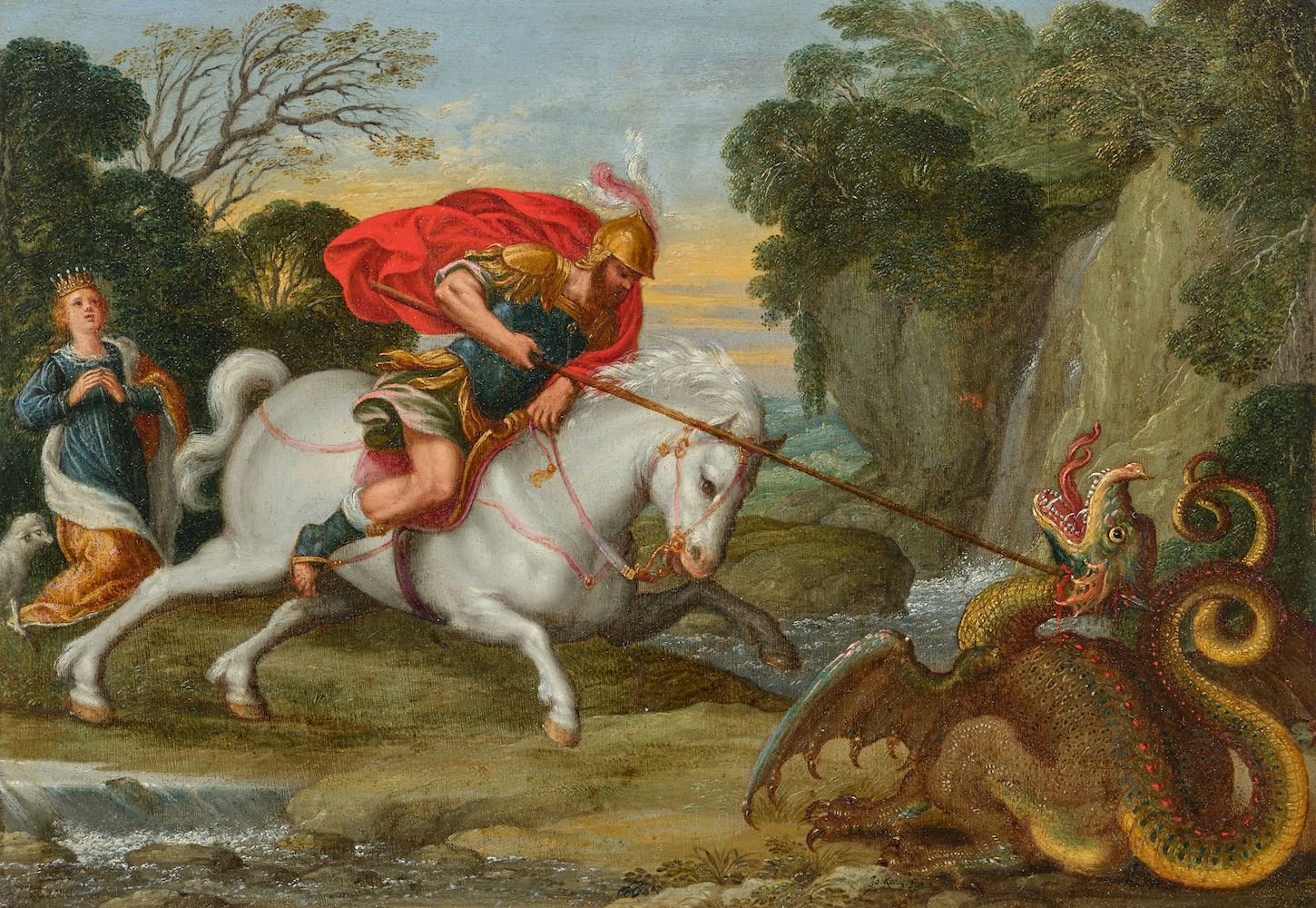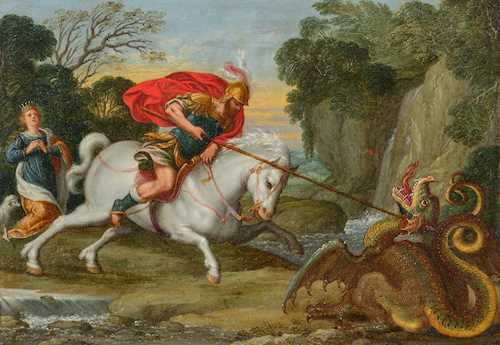
Lotto 3022* - A208 Dipinti antichi - venerdì, 22. marzo 2024, 14h00
JOHANN KÖNIG
(1586 Nuremberg 1632)
Saint George and the Dragon.
Oil on copper.
Signed lower right: Jo: Konig. fc.
14.7 × 21.2 cm.
Provenance:
- Private collection, France.
- Sale Artcurial, Paris, 22.6.2009, Lot 6.
- With John Mitchell Fine Paintings, London.
- European private collection.
‘St George and the Dragon’ by Johann König is undoubtedly one of the most beautiful works by the Nuremberg painter, who achieved great fame particularly for his very finely painted works on copper. The painting offered here is in excellent condition and captivates with its fantastic attention to detail in the pictorial execution as well as its vibrant colours.
Johann König portrays the legend of St George as dragon slayer at the moment of its dramatic climax, a legend first recorded in the mid-13th century in the ‘Legenda aura’ (Golden Legend) by the Dominican Jacobus de Voragine. St George is depicted on his steed fighting the dragon. The form of the advancing white horse, on whose back the saint, his muscles tensed and grasping the lance under his arm, makes his attack, forms a striking counterpoint – also in terms of colour – to the beast in the bottom right-hand corner of the composition. A small flame escaping from the monster's jaws emphasises the climax of the legend. On the left of the picture, behind the dragon slayer, we recognise the Princess Cleodolinda who is praying. Next to her, Johann König shows us the lamb, as an allusion to her impending sacrifice, which, however, is thwarted by the heroic deed of the Christian knight.
Born in Nuremberg, the son of a goldsmith, Johann König spent several years in Venice from 1606 onwards, where he came into contact with the works of the great masters such as Paolo Veronese (1528–1588) and Jacopo Tintoretto (1518–1594). The inspiration that König drew from Venetian painting, and in particular from the art of Tintoretto, is impressively reflected in the painting offered here. A comparison with Tintoretto's ‘St George and the Dragon’, which was painted around 1544 and is now in the Hermitage Museum in St Petersburg (inv. no. ГЭ-194), reveals clear parallels in composition and tonality. However, while Tintoretto's interpretation of the legend of St George is executed on canvas in a relatively large format and emphasises its narrative character by depicting additional figures, König focuses on the essential protagonists of the legend of the saint in his small-format painting. By placing the Christian knight between the princess and the dragon, König skilfully emphasises the drama of the story and thus creates a unique tension in the painting. In addition to the insights König was able to glean while in Venice, the present painting also reflects the artistic inspiration he gained during his stay in Rome from 1610 to 1614. In Rome, König kept company with Johann Rottenhammer (1564–1625) and Adam Elsheimer (1578–1610), among others, who had a decisive influence on König's painterly style. In particular, König must have come into contact with Elsheimer's painting in Rome, as his strong influence on the painterly execution of the landscapes and the use of light in König's works is unmistakable – also in our painting. These art-historical aspects are among the reasons why the painting offered here can be dated to Johann König's Roman period, a view also supported by Dr Gode Krämer, who considers this painting to be one of König's most important works.
An additional distinctive feature of our painting is the filigree brushwork on the copper plate. Around 1600, copper was not only one of the most precious supports for painting, but it also enabled artists to employ an extremely fine painting technique and accentuated the vibrant quality of the colours. The advantages of copper as a medium are also eminently apparent in König's ‘Saint George and the Dragon’: the nature of the material allows König to create a wonderfully detailed painting with the finest of brushstrokes, and the resulting dynamism and richness of colour lend it a radiant quality.
At the same time, the compact format of our painting on copper allows for a very personal form of art appreciation: the filigree masterpiece invites you to take it in your hand and admire it at close proximity. If you look closely, you can not only marvel at the virtuosity of the figures, the lively design of the landscape and the fantastic rendering of the dragon scales, but also discover König’s precise signature on the stone at the lower right of the picture.
The legend of St George and the dragon is a widely recognised and highly valued motif in art history. Paintings of the dragon slayer can be found not only in Tintoretto's work, as already mentioned, but also in the works of other masters such as Paolo Uccello (1397–1475), Giovanni Bellini (ca. 1430–1516) and Raphael (1483–1520). The painting by Johann König offered at auction here seamlessly joins the ranks of the depictions of dragon slayers by those virtuoso masters and vividly symbolises the timeless idea of the triumph of good over evil.
- Private collection, France.
- Sale Artcurial, Paris, 22.6.2009, Lot 6.
- With John Mitchell Fine Paintings, London.
- European private collection.
‘St George and the Dragon’ by Johann König is undoubtedly one of the most beautiful works by the Nuremberg painter, who achieved great fame particularly for his very finely painted works on copper. The painting offered here is in excellent condition and captivates with its fantastic attention to detail in the pictorial execution as well as its vibrant colours.
Johann König portrays the legend of St George as dragon slayer at the moment of its dramatic climax, a legend first recorded in the mid-13th century in the ‘Legenda aura’ (Golden Legend) by the Dominican Jacobus de Voragine. St George is depicted on his steed fighting the dragon. The form of the advancing white horse, on whose back the saint, his muscles tensed and grasping the lance under his arm, makes his attack, forms a striking counterpoint – also in terms of colour – to the beast in the bottom right-hand corner of the composition. A small flame escaping from the monster's jaws emphasises the climax of the legend. On the left of the picture, behind the dragon slayer, we recognise the Princess Cleodolinda who is praying. Next to her, Johann König shows us the lamb, as an allusion to her impending sacrifice, which, however, is thwarted by the heroic deed of the Christian knight.
Born in Nuremberg, the son of a goldsmith, Johann König spent several years in Venice from 1606 onwards, where he came into contact with the works of the great masters such as Paolo Veronese (1528–1588) and Jacopo Tintoretto (1518–1594). The inspiration that König drew from Venetian painting, and in particular from the art of Tintoretto, is impressively reflected in the painting offered here. A comparison with Tintoretto's ‘St George and the Dragon’, which was painted around 1544 and is now in the Hermitage Museum in St Petersburg (inv. no. ГЭ-194), reveals clear parallels in composition and tonality. However, while Tintoretto's interpretation of the legend of St George is executed on canvas in a relatively large format and emphasises its narrative character by depicting additional figures, König focuses on the essential protagonists of the legend of the saint in his small-format painting. By placing the Christian knight between the princess and the dragon, König skilfully emphasises the drama of the story and thus creates a unique tension in the painting. In addition to the insights König was able to glean while in Venice, the present painting also reflects the artistic inspiration he gained during his stay in Rome from 1610 to 1614. In Rome, König kept company with Johann Rottenhammer (1564–1625) and Adam Elsheimer (1578–1610), among others, who had a decisive influence on König's painterly style. In particular, König must have come into contact with Elsheimer's painting in Rome, as his strong influence on the painterly execution of the landscapes and the use of light in König's works is unmistakable – also in our painting. These art-historical aspects are among the reasons why the painting offered here can be dated to Johann König's Roman period, a view also supported by Dr Gode Krämer, who considers this painting to be one of König's most important works.
An additional distinctive feature of our painting is the filigree brushwork on the copper plate. Around 1600, copper was not only one of the most precious supports for painting, but it also enabled artists to employ an extremely fine painting technique and accentuated the vibrant quality of the colours. The advantages of copper as a medium are also eminently apparent in König's ‘Saint George and the Dragon’: the nature of the material allows König to create a wonderfully detailed painting with the finest of brushstrokes, and the resulting dynamism and richness of colour lend it a radiant quality.
At the same time, the compact format of our painting on copper allows for a very personal form of art appreciation: the filigree masterpiece invites you to take it in your hand and admire it at close proximity. If you look closely, you can not only marvel at the virtuosity of the figures, the lively design of the landscape and the fantastic rendering of the dragon scales, but also discover König’s precise signature on the stone at the lower right of the picture.
The legend of St George and the dragon is a widely recognised and highly valued motif in art history. Paintings of the dragon slayer can be found not only in Tintoretto's work, as already mentioned, but also in the works of other masters such as Paolo Uccello (1397–1475), Giovanni Bellini (ca. 1430–1516) and Raphael (1483–1520). The painting by Johann König offered at auction here seamlessly joins the ranks of the depictions of dragon slayers by those virtuoso masters and vividly symbolises the timeless idea of the triumph of good over evil.
CHF 300 000 / 500 000 | (€ 309 280 / 515 460)
Venduto per CHF 187 500 (incl. premio dell'acquirente)
Non si assume alcuna responsabilità per la correttezza di queste informazioni.


